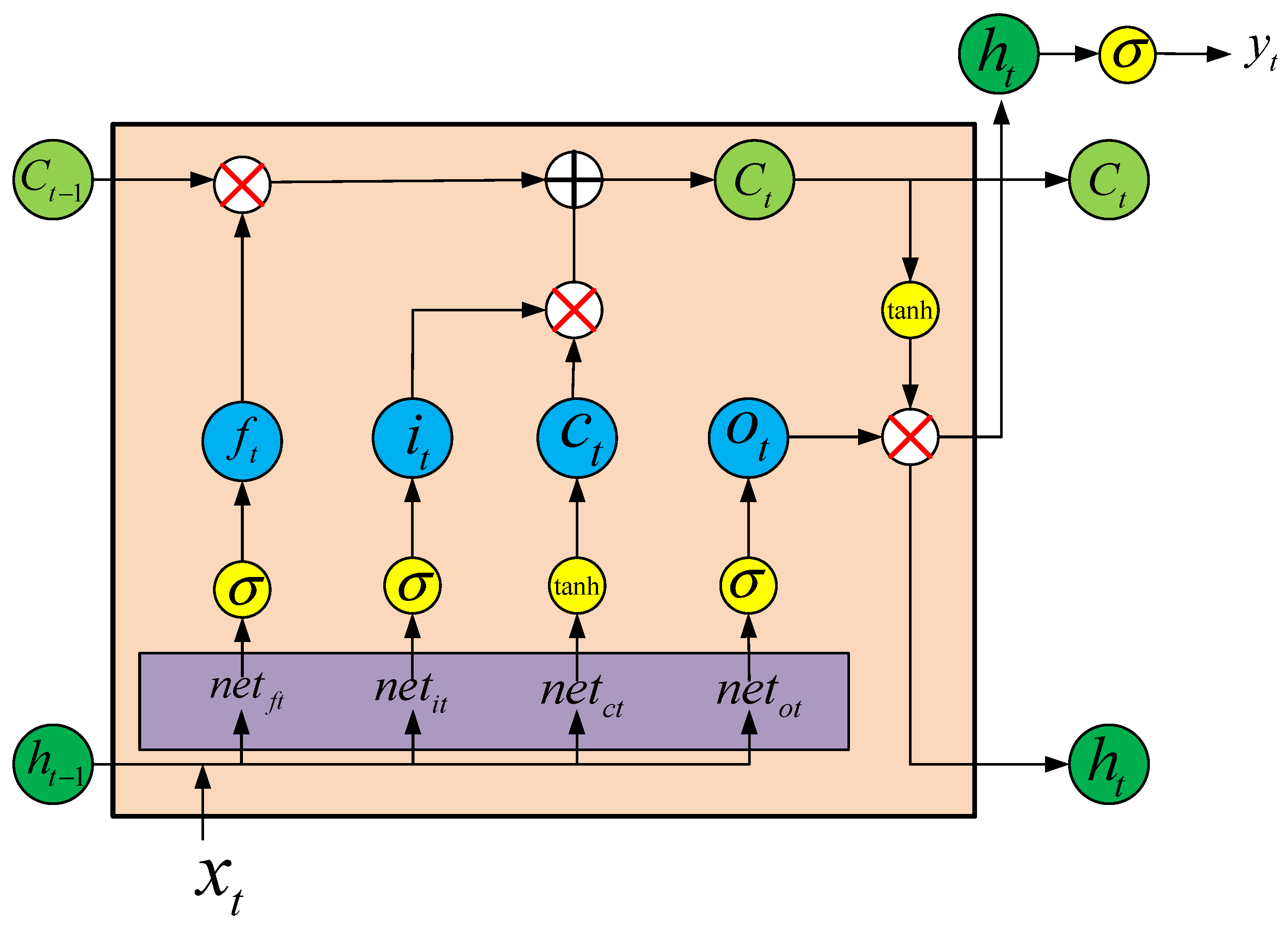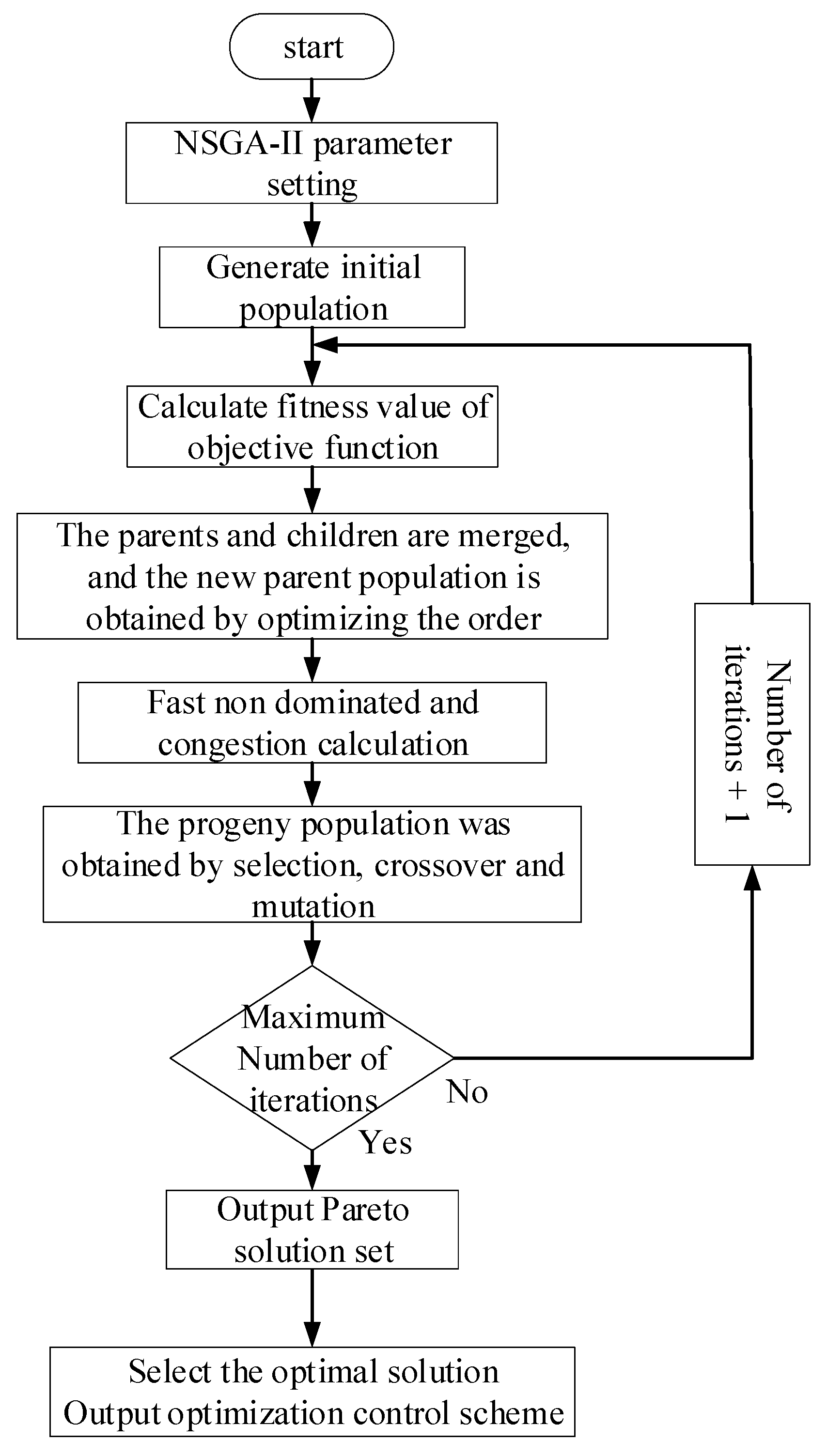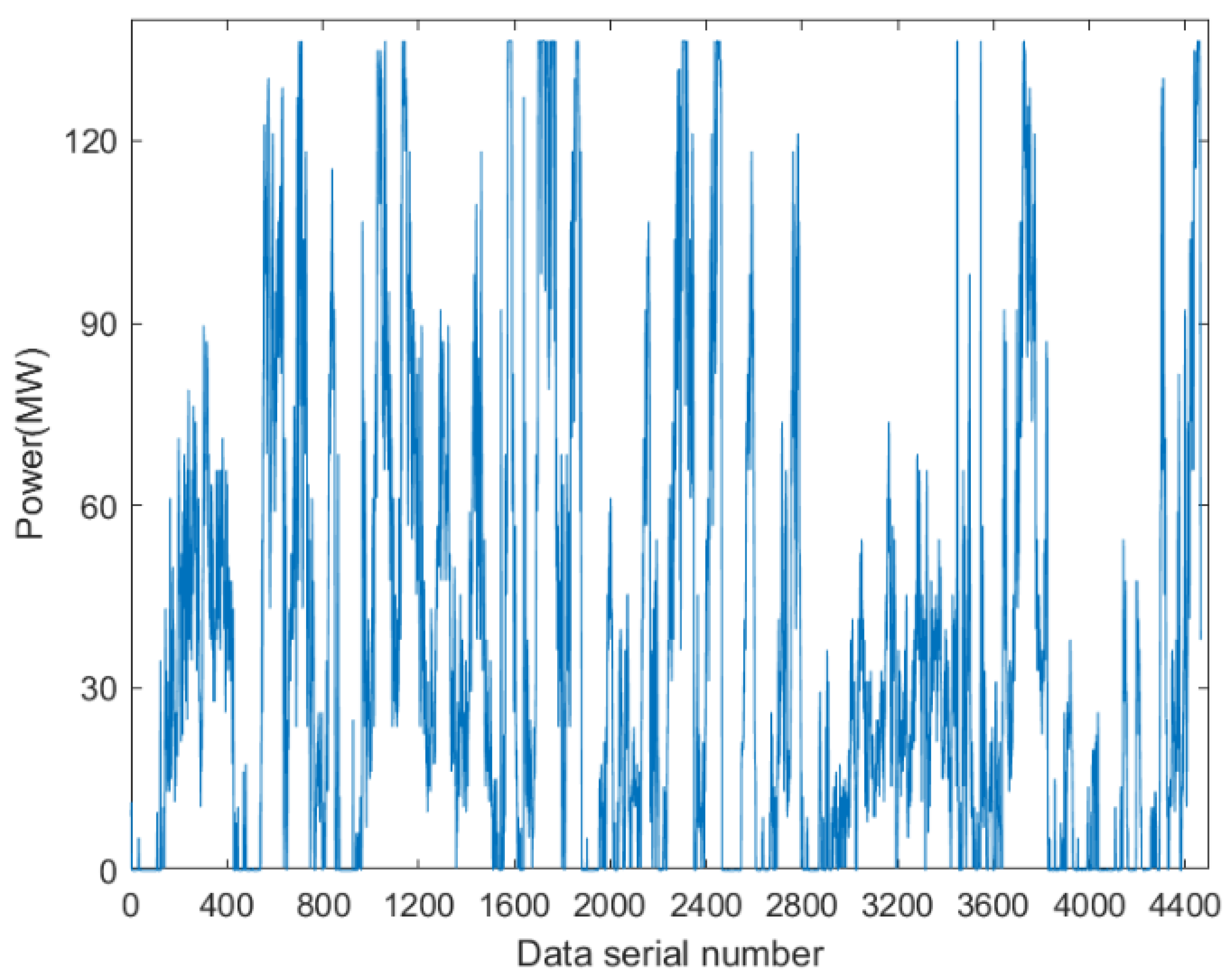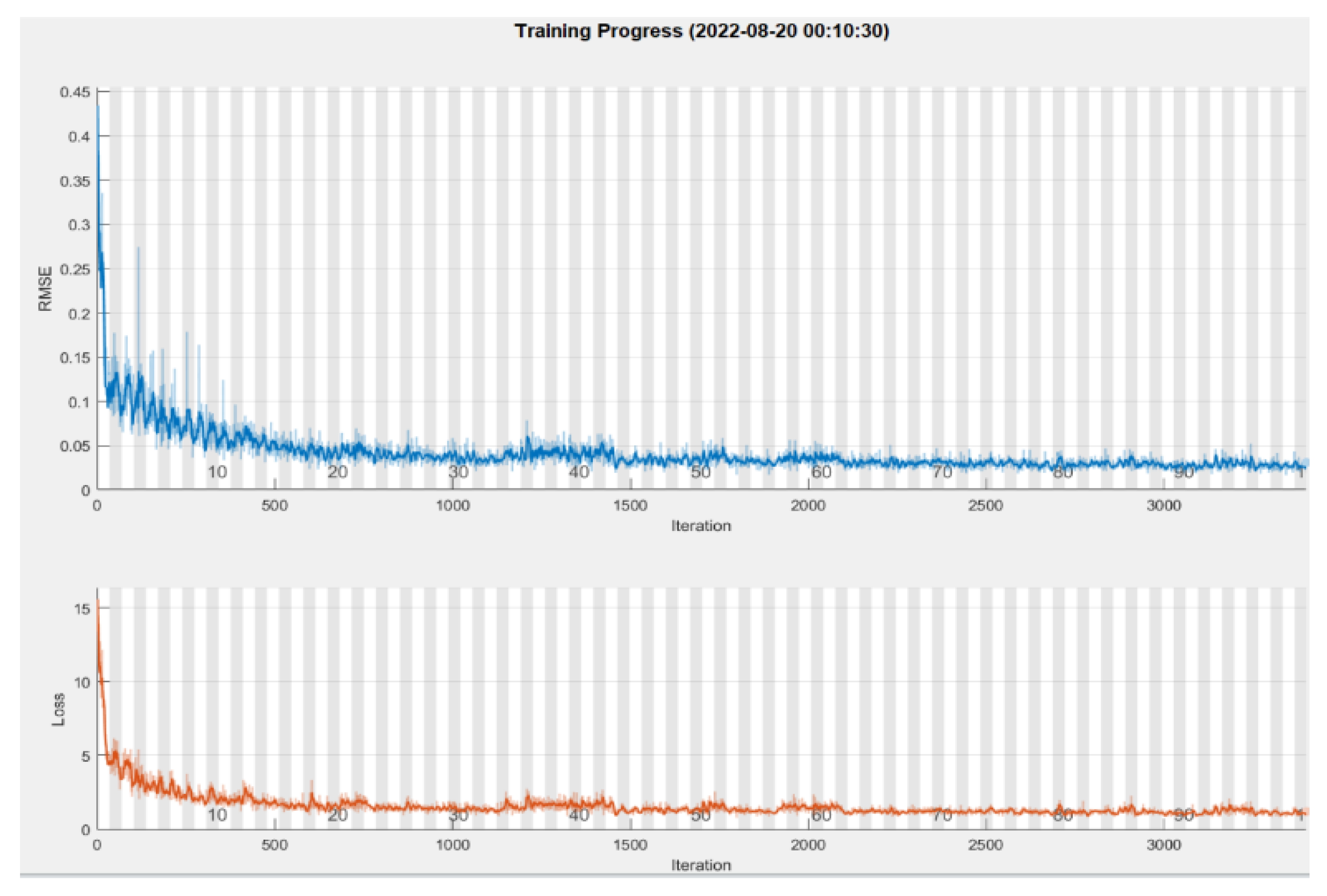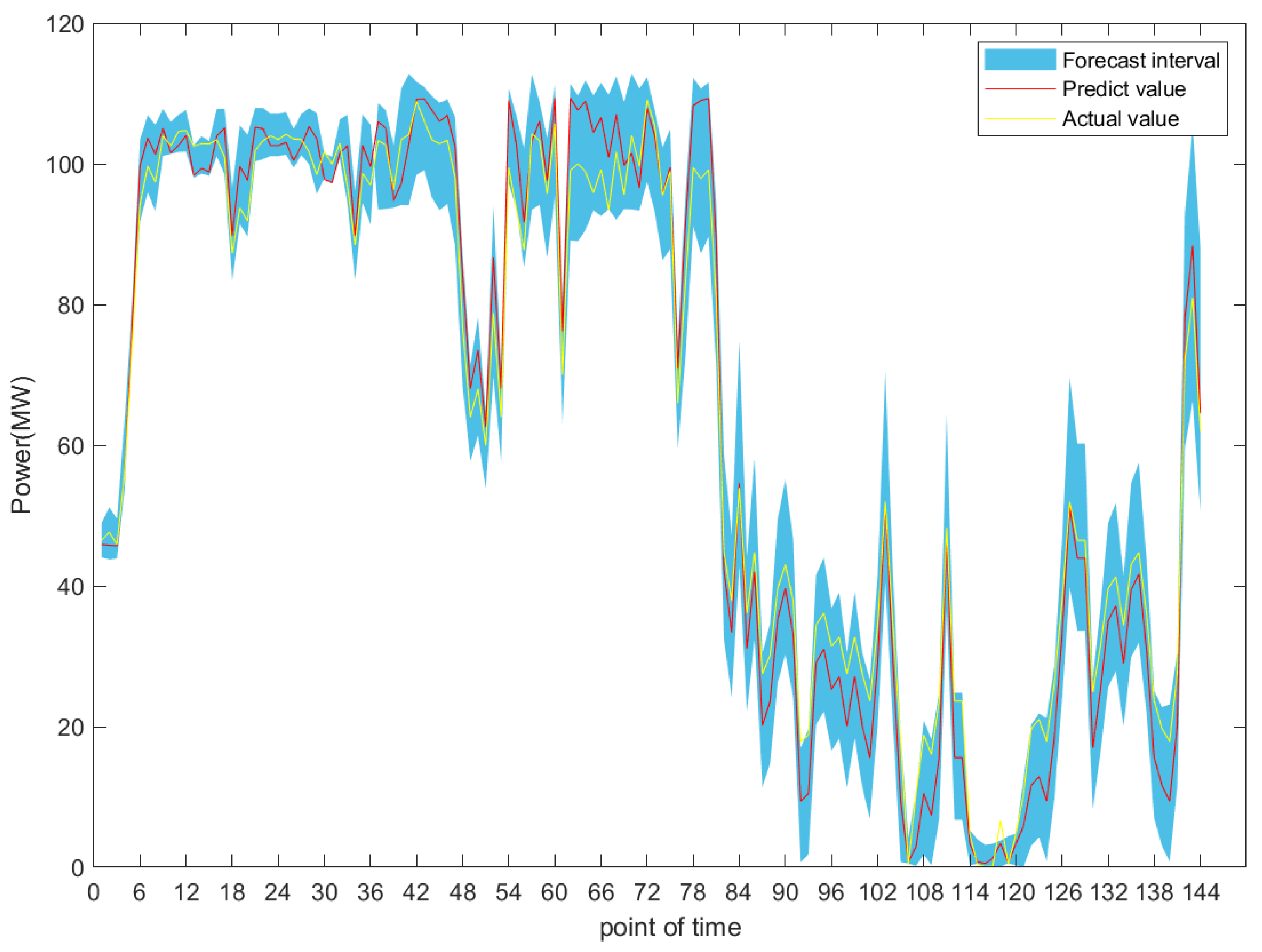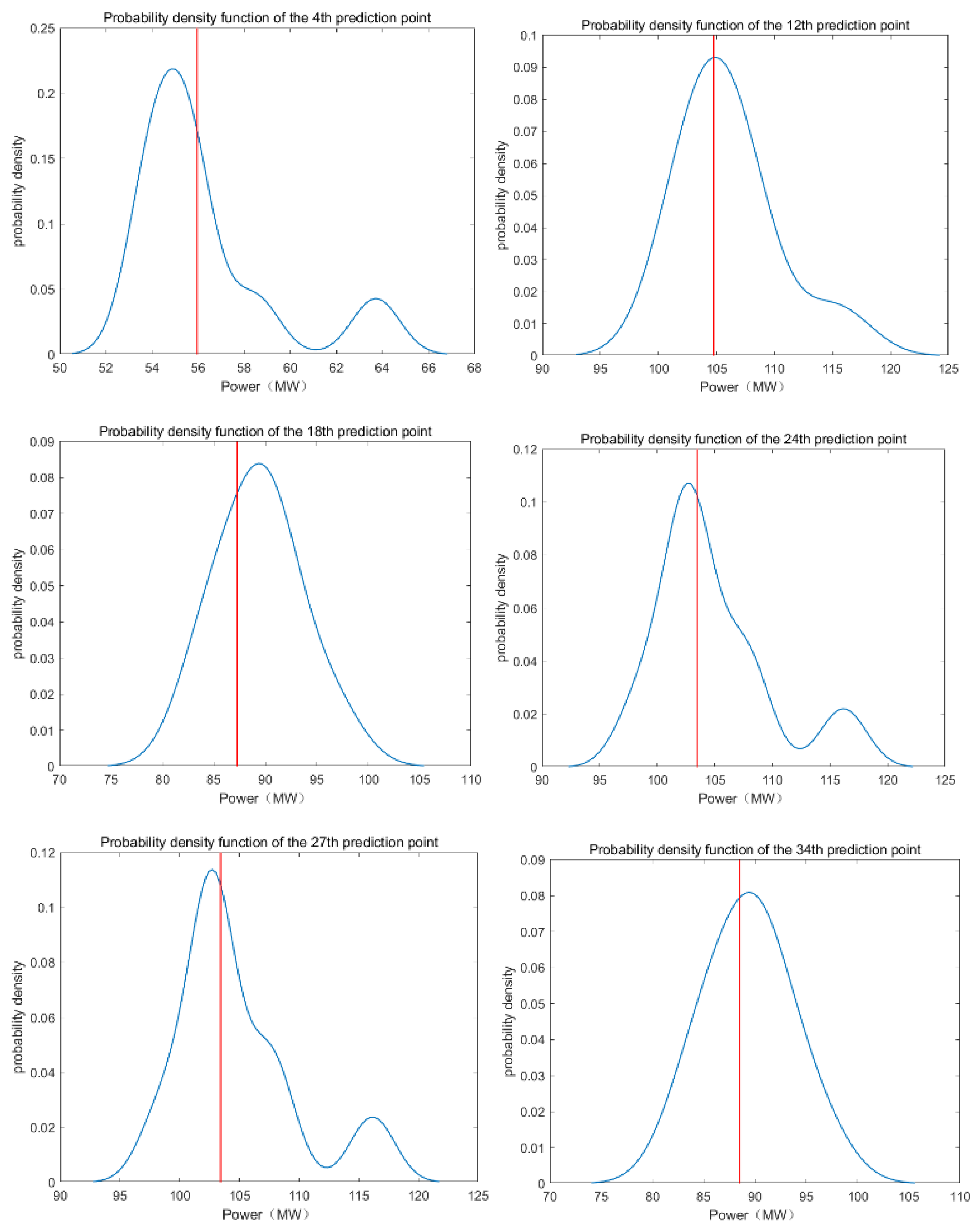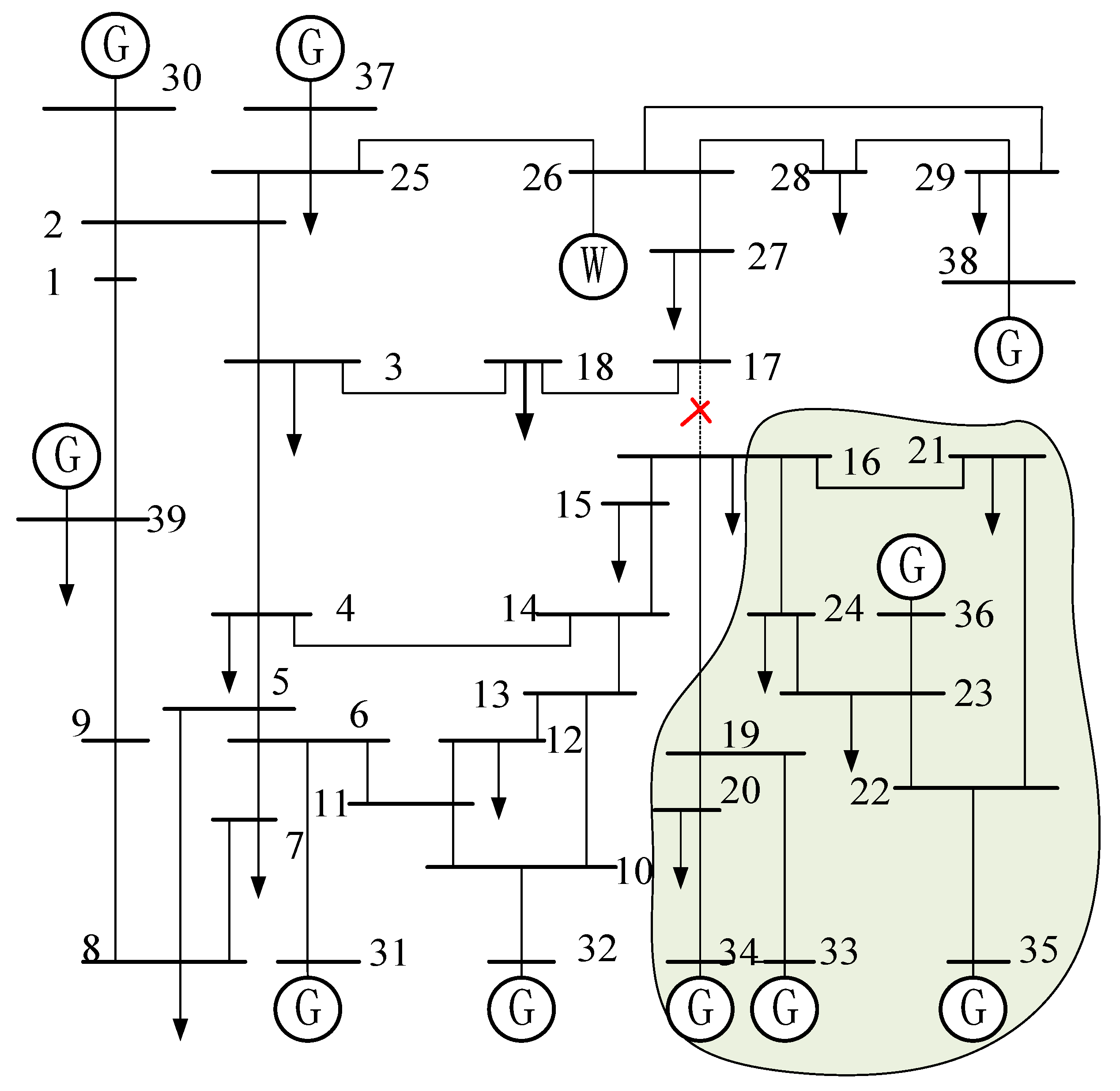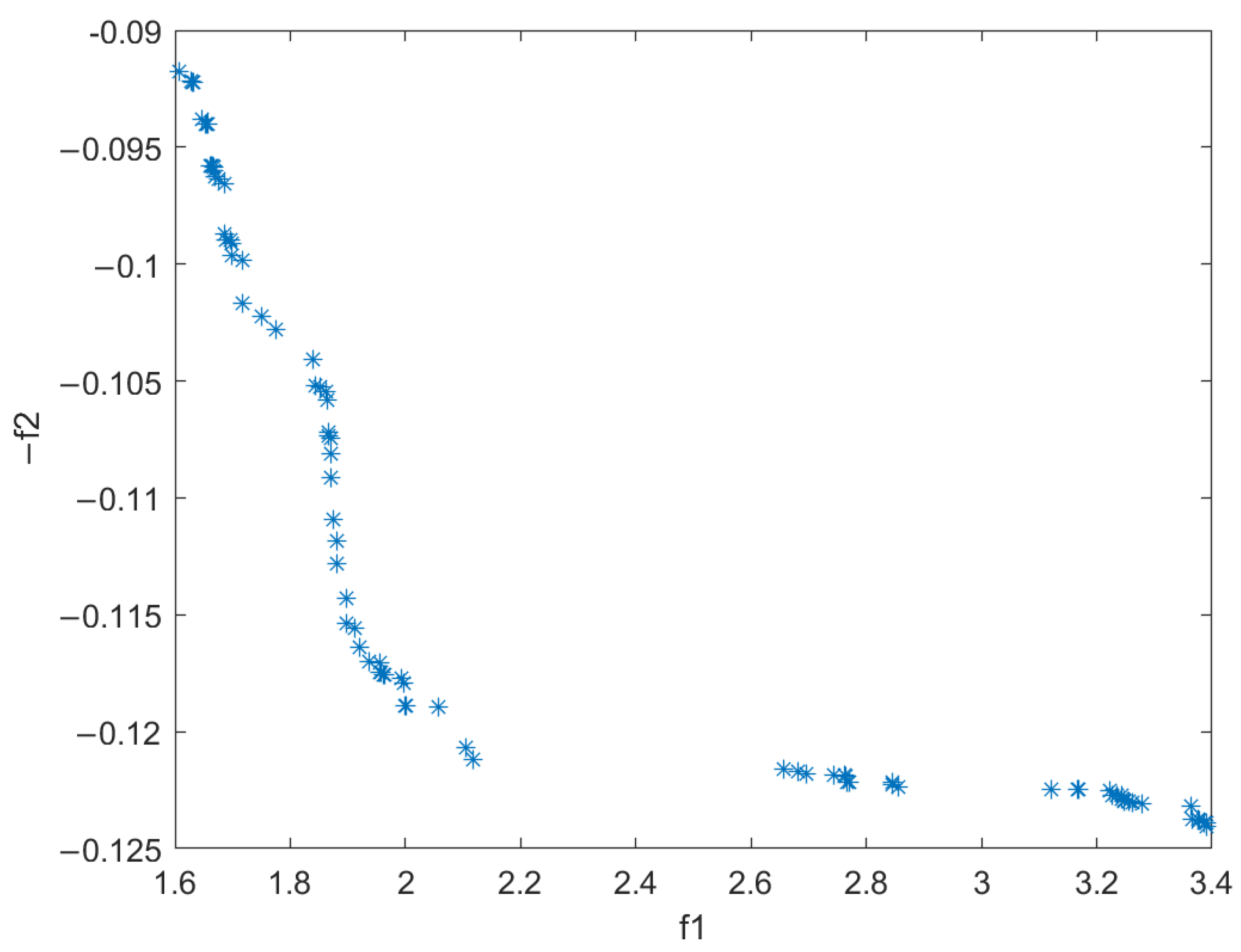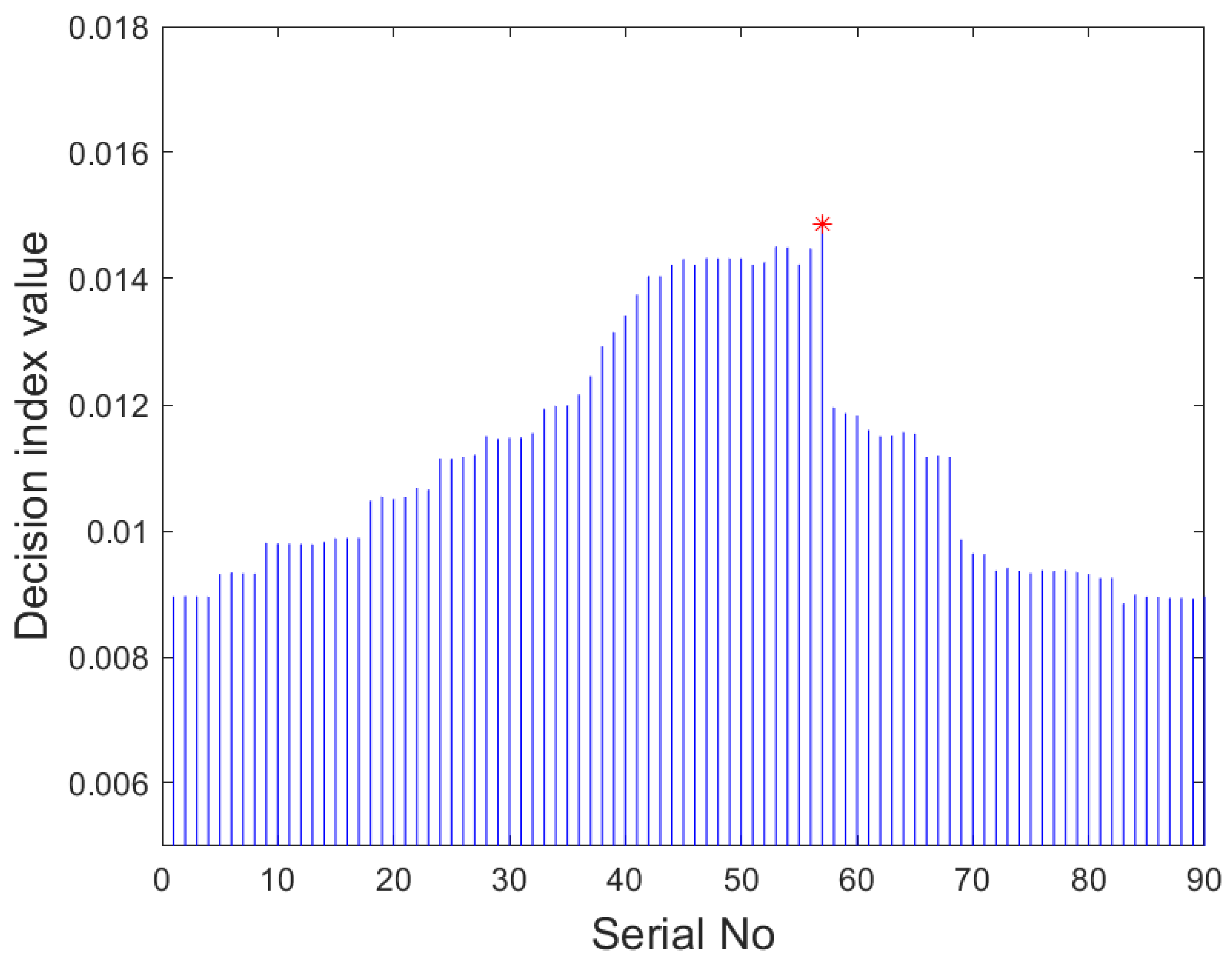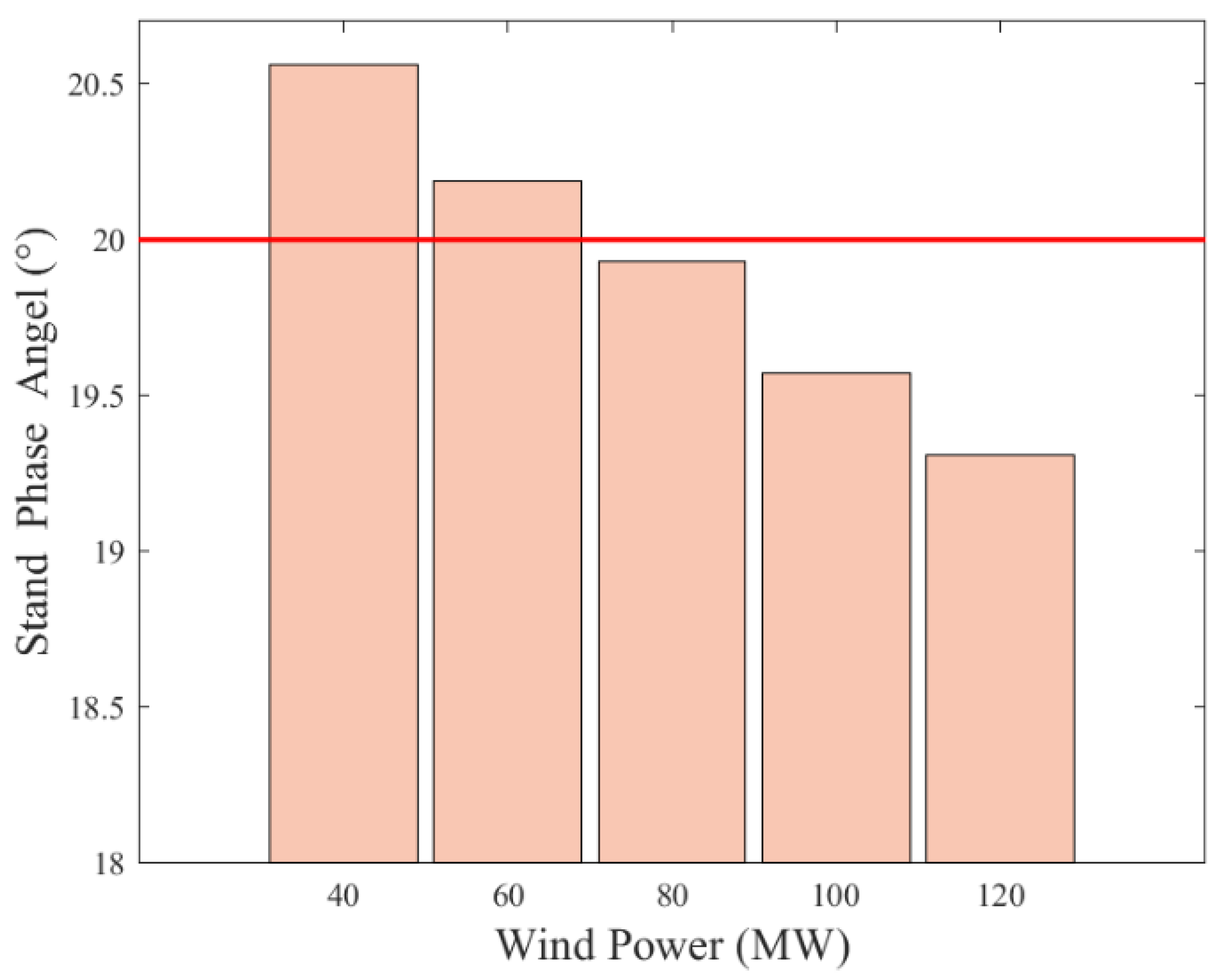1. Introduction
Building new power systems based on renewable energy has become a hot topic in the context of energy structure transformation. Due to the rapid development of renewable energy, the power system has changed from the traditional deterministic system to a strong stochastic system. Unlike the traditional conventional units, the new energy generation represented by wind and photovoltaic technologies is heavily dependent on changes in weather conditions and environmental factors. The output is intermittent and volatile. Its large-scale grid connection is bound to change the original power flow distribution of the power system The wide access of new loads such as electric vehicles has exacerbated the uncertainty of the source load of the power system and brought severe challenges to the safe, economic, and stable operation of the system [
1]. Therefore, compared with the traditional power system, the uncertainty factors of the new power system under the energy transformation have increased dramatically, and research on the uncertainty of power systems has received extensive attention.
Probability prediction is widely concerned with the quantitative analysis of prediction uncertainty through the probability distribution of prediction uncertainty [
2]. In [
3], a probability density forecasting method is proposed in power system load forecasting, which can not only be used for regional load forecasting but also is extended to the field of new energy output forecasting and price forecasting. In [
4], support vector quantile regression based on kernel function (KSVQR) is used to predict short-term power load. After the copula theory is used to analyze the correlation of the factors affecting the load, the accuracy of prediction is further improved. The authors of [
5] established a comprehensive probability-prediction model by combining concept learning and machine learning. The model effectively reduces the error value of midpoint prediction in the process of flood prediction and reduces the uncertainty of prediction. The authors of [
6] established and realized a short-term load forecasting model based on Gaussian process quantile regression (GPQR), but its calculation efficiency is greatly reduced when the amount of data is large. In distribution networks, a large number of flexible loads are connected, which aggravates the uncertainty of the system. In [
7,
8], the probability densities of building load and charging pile load are predicted by combining kernel density estimation and LSTM neural network, and the validity of the proposed models are verified, respectively. To improve the accuracy of short-term load forecasting in microgrid optimal dispatching, the authors of [
9] proposed a load probability density forecasting method based on K-means deep learning regression. The authors of [
10] established a short-term user power load probability prediction method based on a random forest algorithm, and the verification shows that the method can be applied to users with different power-consumption behaviors. The authors of [
11] established a neural network model based on the least absolute shrinkage and selection operator (LASSO) quantile regression and analyzed the influence of multidimensional factors on power-load forecasting.
The massive access to new energies, such as wind and solar energies, has significantly increased system uncertainty, has increased the difficulty of power system planning and dispatching, and has effectively suppressed the output fluctuation of new energies [
12]. However, in the whole prediction chain from meteorological prediction to end users, it is difficult to eliminate the prediction error and related uncertainty. Therefore, it is necessary to analyze the source and propagation mode of prediction uncertainty to implement a more reasonable and uncertainty-oriented guidance scheme [
13]. The authors of [
14] suppress the fluctuation of wind-power output and reduced the impact of wind-power uncertainty on the safe operation of power systems by establishing a hybrid wind-storage system. The authors of [
15] used historical statistical information to transform the traditional prediction sequence of new energy output into an output scenario set, and realized the short-term joint dispatching of wind, water, and solar energy. The authors of [
16] established a wind-power probability density prediction model based on cubic spline difference and support vector quantile regression (CSI-SVQR), and used a quartile method and CSI function to preprocess the data to improve the prediction accuracy. The authors of [
17] considered data uncertainty and model uncertainty, respectively, in the prediction process, which improved the performance of their probability distribution prediction. In [
18], considering the multi-timescale probability characteristics in wind-power probability prediction, a super-short-term wind-power probability-prediction model (TMDN) based on a mixed-time-series density network was established. In order to solve the operational risk problems, such as the tie line which can be overrun in power grid dispatching control, the authors of [
19] constructed a rolling probability-prediction model based on short-term memory network and a support vector machine to effectively avoid the system operational risk. The authors of [
20] introduced an information-gap decision-making theory to deal with the price uncertainty in the power market; using this, it is not necessary to obtain the probability distribution of the uncertain factors for modeling. The authors of [
21] introduced blockchain technology in improving system security to reduce system line congestion and operation risk.
Recovery control after a power outage is an important aspect of power system security defense [
22]. After a power outage, the parallel recovery of each subnetwork can effectively speed up the recovery process, and the new energy access represented by wind and power can improve the ability of the power grid to quickly recover from the interruption [
23,
24]. However, the uncertainty of wind-power output brings new challenges to the formulation of system recovery schemes [
25], and inappropriate recovery schemes may cause the risk of secondary power outages [
26]. The authors of [
27] studied a model and scheme that can quickly restore the load in the case of multiple faults in an integrated energy system. In order to solve uncertain problems such as the output of wind and new energy, the authors of [
28] adopted the Monte Carlo method, and took the minimization of the cost in the recovery process as the objective, adopting a dynamic programming method. The authors of [
29] described the uncertainty of load and scenery through conditional value at risk (CVaR), constructing a two-stage load recovery optimization model, and effectively solved the uncertainty in load recovery by solving linear programming and mixed-integer quadratic programming. The authors of [
30] proposed a prediction method considering the increase in cooling load demand during load recovery, and took electric vehicle load as an example for explaining the impact process of the increase in cooling load demand on system recovery. The authors of [
31], established a mixed-integer programming model to reduce the phase angle difference at both ends of the line to be paralleled, and part of the load was restored simultaneously; this approach was proposed to solve the problem of the closing angle exceeding the limit in the process of subnetwork paralleling. In [
32], a robust optimization model for load recovery was established on the basis of considering wind-power prediction errors, and uncertainty was treated in the way that uncertainty sets are treated. In [
33], considering the participation of new energy sources, a secondary scheduling strategy was proposed to improve the degree of load recovery while ensuring the reliability of the power system through three-stage optimization. The authors of [
33] analyzed the system recovery of energy storage and distributed power supply in a distribution network and proposed a two-level optimal recovery strategy considering the power supply modes of different power sources; this study had the objective of minimizing costs in the recovery process and restoring the largest possible number of power supply users. The authors of [
34,
35,
36] analyzed the impact of a DC system and a wind power connection on system recovery in an AC/DC hybrid power system; they established a load-recovery model considering source load uncertainty which effectively balanced safety and stability in recovery, and ensured the coordination and optimization of DC transmission power and the safe access of load. Considering the problem of line overload in system recovery caused by large-scale access to wind power, the authors of [
37] eliminated line overload through ring network reconstruction by building a regional ring network in which the wind-power output was scenario based; the upper layer of the optimization model, with minimum operation complexity, and the lower layer of the model, with the constraint of the angle to be paralleled and closed, were established, and the effectiveness of the model was verified. In the process of load recovery, one of the most important processes is to strengthen the connection between systems through a parallel connection between subnets, improve the stability of the system, and speed up the recovery of load. In the process of parallel connection, it is necessary to limit the voltage and phase angle at both ends of parallel elements or lines [
38]. The authors of [
39] established a multiobjective model for load recovery to improve the power supply quality of subnetworks and minimize the parallel closing angle between subnetworks; they used a water cycle algorithm (WCA) to solve the model. In the optimal regulation of the closing angle of the power system ring grid parallel, and considering the influence of the uncertainty of the wind-power output on the closing angle, the authors of [
40] represented the uncertainty of the wind farm output collectively; a two-stage robust optimization model was established, which takes the minimum charge of the unit output and restores part of the load at the same time. However, due to the limitations of the robust optimization itself, it is difficult to quantify the uncertainty; as a result, the solution scheme is conservative and subjective in the weight distribution of the solution objective, and it is difficult to guarantee the quality of the solution. Improving the flexibility of the power system has a great effect on improving the recovery capacity of the power system [
41]. The authors of [
42] further summarized the recovery technologies and optimization methods of future smart grids. In the context of increasing penetration of new energy such as wind and solar energy, it is necessary to analyze and study the recovery stage of power systems after wind and solar energy are connected, to deal with the impact of its output uncertainty on the system-recovery process.
Table 1 summarizes the characteristics of the models and solution methods established during power-system restoration.
According to
Table 1, the current research on the system-recovery phase has the following deficiencies:
In some studies, the impact of uncertainty factors on systems was not considered in the system-recovery phase, and the goal in the recovery phase was singular.
In the treatment of system uncertainty factors, the adopted method has limitations such as low calculation efficiency and conservative solution results.
Based on this, the following methods can be adopted to make up for the shortcomings of current research:
Probability density prediction is adopted to solve the impact of wind-power output uncertainty on the system-recovery process;
Based on a consideration of the uncertainty of wind-power output, a multiobjective optimization model is established to minimize the adjustment of unit output and maximize the recovery of important loads.
Therefore, this paper studies the optimal control of the closing angle of the subgrid parallel process in the power-system-recovery process. Based on considering the uncertainty of the wind-power output, the subgrid parallel process is realized, and the power loss load is restored to speed up the system-recovery process. Firstly, the uncertainty of wind-power output is described in the form of probability density prediction, and a probability-prediction model of wind-power output based on quantile regression LSTM is established. Based on predicting future wind-power output intervals, the probability density function of the output at each time point in the future is obtained through kernel density estimation, and various output probability scenarios of wind power are integrated through weight addition to improve the accuracy of wind-power prediction. The influence of wind-power output uncertainty on the closing angle and adjustment scheme is fully considered. Then, based on a consideration of the probability of wind-power output, a control model to reduce the phase angle difference at both ends of the parallel point is established by adjusting the active power output of the conventional units of the system and assigning as the control measure the load to be restored after power failure. In the regulation process, the multiobjective collaborative optimization is carried out with the minimum output adjustment sum of conventional units and the maximum input of important loads to be restored, and the NSGA-II algorithm is used to solve the established model. Finally, the effectiveness of the proposed method and model is verified by the IEEE 39-bus system simulation.
2. Prediction of Wind-Power probability Density Based on Quantile Regression LSTM
2.1. Quantile Regression Model
The principle of quantile regression is to split the data according to the dependent variable, form multiple quantiles, and study the regression relationship under multiple quantiles. In general, quantile regression has the following functions:
- (1)
Analyze the influence trend of influencing factor X on variable Y.
- (2)
Stability analysis for the regression model.
The assumed distribution function of the random variable is shown in Formula (1).
The
quantile of
Y is defined as the minimum value
, satisfying
, as shown in Formula (2).
Assuming that a group of random samples of
Y is
and that this is affected by
k influencing factors
, the quantile regression of samples essentially minimizes the sum of absolute values of weighting errors, and the calculation formula is shown in Formula (3).
where
represents the
conditional quantile under the dependent variable
y independent variable
;
represents the regression coefficient vector at the
quantile. Its expansion is shown in Formula (4).
where
is the inspection function. The definition formula is shown in Formula (5).
where
is an indicator function,
is a conditional relationship, and when
is true,
, and vice versa:
.
For the conditional quantile function, the parameter estimation value can be obtained by solving Formula (4), as shown in Formula (6).
In Formula (6), arg min represents the value of when the function takes the minimum value.
From the above analysis, for any , the parameter is referred to as the regression quantile coefficient. The essence of quantile regression is to estimate different conditional quantiles of dependent variables by taking different values and using independent variables.
2.2. Network Model of Long- and Short-Term Memory
The traditional quantile regression model can effectively reflect the influence of independent variables on the distribution range and shape of dependent variables, but it is not suitable for nonlinear new energy output prediction. Taylor proposed a neural network quantile regression model (QRNN) by combining the nonlinear fitting of the neural network with the data analysis ability of QR. Based on the training mechanism of the original recurrent neural network (RNN), the network training results are more inclined to new information but show weak memory function. To solve the long-term dependence on RNN training, Hochreiter and Schmidhuber proposed the long-term and short-term memory network.
As a variant of the recurrent neural network, LSTM has a basic structure, as shown in
Figure 1. LSTM is represented as a chain structure by time expansion, and the repetitive module of LSTM contains four neural network layers. The hidden layer in the RNN is replaced by a memory unit in the LSTM to realize effective memory of past information.
In the RNN network, the hidden layer has only one state, , and a cell state, , is added to the LSTM. Compared with the original RNN network, the LSTM is expanded according to the timeline, and the inputs are increased to three, including the cell state at the previous time, the output at the previous time, and the input at the current network. The outputs are increased to two, namely, the output of the LSTM at the current time and the cell state at the current time.
The LSTM has four gates in total. At each time, the LSTM receives the current time input , the previously hidden state output , and the memory cell state through three gates.
The first layer of neurons is the forgetting gate control layer, which helps LSTM decide to delete some information in the memory cell state, as shown in Formula (7).
The second layer and the third layers are the input gate and tanh layer, respectively, as shown in Formulas (8) and (9). Using the input gate,
, to determine the new information,
, to be stored in the new cell state, the tanh layer creates a new candidate value—
.
where
determines how much information is forgotten
;
determines how much information is stored in the new cell state
.
Finally, calculate
through the output gate,
. As shown in Formula (11), after Formula (10) passes through the tanh layer, it is multiplied by the output gate to bring the forgetting and memory parameters to the final output.
where
are the weight and offset of the forgetting gate and the input gate, respectively;
are the updated value and the weight and offset of the output gate, respectively;
is an activation function;
is a tangent activation function. Reference numeral
denotes a combination of matrices having the same number of rows.
As a deep neural network with memory ability, LSTM has been widely used in nonlinear sequence prediction. Compared with a static neural network, LSTM can better explore the correlation between sequence data and is very suitable for dealing with problems highly related to time series [
7,
8].
2.3. Nuclear Density Estimation
As one of the nonparametric estimation methods, kernel density estimation is often used to estimate the unknown density function in probability theory. Nonparametric estimation does not need to assume the distribution function of the sample data in advance. It can directly analyze the sample data, study the data analysis characteristics, simulate the real probability density curve, and realize the estimation of the sample data.
Assuming that there are
random discrete samples
and the probability density function is
, the kernel density estimation formula of the probability density function is shown in Formula (13).
where
is the bandwidth;
is the sample volume;
is a one-dimensional array with equal spacing;
is the
data in the time series sample,
;
is a kernel function. Generally, Gauss, matrix, triangle, etc., can be selected. In this paper, the Gaussian kernel function (GKF) is selected, and the expression is shown in Formula (14).
where
is the smoothing parameter of bandwidth,
, and its height affects the shape of the distribution. The optimal bandwidth can be determined by the plug-in bandwidth selector. In this paper, the empirical rule is used to select the appropriate bandwidth, and the expression is shown in Formula (15).
In Formula (15), is the estimated standard deviation; is the number of samples.
2.4. Wind-Power Probability Density Prediction Process Based on Quantile Regression LSTM
(1) Normalize the obtained historical wind power data, as shown in Formula (16), to reduce the training time and improve the accuracy of the model.
where
is the sample data at a time
, and
are the maximum value and minimum value of all samples, respectively.
(2) Divide the training set and the test set, determine the parameters of each layer in the LSTM network, and preset the required number of loci.
(3) The test set is input into the trained LSTM model for power prediction, and the power prediction results under each quantile are obtained.
(4) The kernel density estimation is performed on the prediction results at each quantile obtained by training, and the probability density function at each prediction point is calculated.
The specific prediction process is shown in
Figure 2.
2.5. Model Evaluation Index
After the wind-power interval-prediction results are obtained, the following two indicators are used to evaluate the accuracy of the model prediction.
(1) Interval coverage (reliability):
The larger the coverage of the interval, the higher the reliability of the model.
where
is the interval coverage rate and
is the number of actual values falling within the interval.
(2) Interval average width (sensitivity):
When the prediction interval is large enough, the reliability of the prediction can be improved. However, at this time, wind power cannot be effectively predicted and has no practical value. Therefore, the average interval width is used to evaluate the prediction interval width to ensure the validity of the prediction.
where
is the average interval width,
is the upper limit value of the
prediction interval, and
is the lower limit value of the
prediction interval.
2.6. Summary
LSTM has a good fitting ability for nonlinear time series and has a good prediction effect in medical protein structure prediction, road traffic flow rate prediction, etc. Probability density is mainly used to obtain the probability density curve, provide the fluctuation range of wind power, and obtain more useful information. Quantile regression is used to combine the two, and regression prediction is conducted under different quantiles. Finally, nuclear density estimation is used to calculate the probability density function, which provides wind power information for the subsequent optimal regulation model of closing angle.
3. Optimal-Control Model of the Parallel Closing Angle of Ring Network Considering Wind-Power Uncertainty
Compared with the radiative grid structure with poor resistance to source and load fluctuations, the ring network can not only improve network security and enhance system transmission capacity but can also withstand the power fluctuations of new energy and better support the recovery of important loads. Through the analysis of the power grid structure and the trend of power flow, the voltage phase angle of the nodes at both ends of the line to be paralleled is studied. Generally, the power grid is divided into the sending end and the receiving end according to the voltage phase angle of the nodes at both ends. By reducing the active power from the sending end to the receiving end, the phase angle difference of the node voltages at both ends can be effectively reduced. Generally, the phase angle difference at both ends is reduced by inputting the load at the sending end and increasing the output of the unit at the receiving end.
Due to the uncertainty of wind-power output, the fluctuation of active power output after grid connection will cause the power flow fluctuation of the access point, thus causing the phase angle fluctuation of the point to be paralleled. Through the probability density prediction of wind-power output, this paper not only further improves the prediction accuracy, but also integrates various output probability scenarios of wind power, and fully considers the impact of the uncertainty of wind-power output on the closing angle and the adjustment scheme.
Based on considering the uncertainty of new energy output, this paper establishes a control model to reduce the phase angle difference at both ends of the parallel point by adjusting the active output of the conventional unit of the system and putting the load to be restored after power failure as the control measure. In the process of regulation and control, multiobjective collaborative optimization is carried out considering that the sum of output adjustment of conventional units is the smallest and the most important loads to be restored are input.
3.1. Objective Function
(1) Minimum sum of the regulated output of the conventional unit
During system recovery, to speed up the system-recovery process and reduce the regulation cost, the minimum output adjustment sum of conventional units in the regulation process is taken as the objective function I, which is defined as:
where
is the probability value of different output scenarios of wind power;
is the adjustment value of generator output considering different wind-power output probabilities;
is the initial output value of the conventional unit;
is the number of generator nodes.
(2) Maximum weight of the load to be restored
In the process of system restoration, the load with high importance shall be preferentially restored to minimize the outage loss. Therefore, objective function II is to maximize the total load restoration weight in the regulation process, which is defined as:
where
represents whether the feeder
connected to the node
is restored. If it is restored, the value is 1—otherwise, it is 0;
is the load weight of the feeder
connected to the node
;
is the load value of the feeder
connected to the node
;
is the total number of system nodes;
is the number of feeders connected to a node
.
Based on the objective function of the minimum sum of the regulated output of conventional units and a maximum weight of the load to be restored, the general objective of optimal control of the parallel closing angle of the ring network is defined as follows:
3.2. Constraint Condition
The constraints included in the model are as follows:
Formulas (22)–(31) are the constraint conditions to be met in the process of closing angle regulation. Equations (22) and (23) are constraints of active power balance and reactive power balance of nodes, where , are the restored loads of node ; , are the active output and reactive output of the wind farm, respectively, connected to node under different probabilities, ; , are the active output and reactive output of the conventional unit connected to node , respectively. Equations (24) and (25) are the active and reactive power calculation formulas of the line flowing through the end, where , is the voltage of the node , ; , and are the conductance and susceptance of the line and the phase angle difference of the nodes at both ends of the line, respectively; is the susceptance parameter of the end to the ground branch of the type equivalent circuit of the line . Equations (26)–(29) are inequality constraints for safe operation of the power system, which are unit active output constraints, unit reactive output constraints, node voltage constraints, and tie line transmission power constraints; here, and are the initial active output and reactive output of conventional units, respectively. During system recovery, the system has a large power loss load, and most units are in an upward-climbing state. To accelerate the recovery process, It is required that all units are not allowed to operate with reduced output; and are the maximum active output and reactive output allowed for unit operation, respectively; and are the allowable lower and upper limits of the node voltage, respectively; is the maximum power allowed to flow through the line . Equation (30) is the phase angle difference constraint at both ends of the line to be paralleled and is the maximum setting value allowed in system recovery. Equation (31) is the constraint of system frequency change caused by load input and is the maximum frequency drop value caused.
3.3. Model Solving
The optimal-control model of the parallel closing angle of the power system loop network considering the uncertainty of wind-power output established in this paper is a multiobjective nonlinear programming problem, and its standard form is:
where
and
are the two objective functions of minimum unit output adjustment and maximum load weighted recovery, respectively;
is an
-dimensional decision variable, including the output value of the conventional unit after adjustment, determining whether the feeder connected to each bus is restored;
is an equality constraint function;
is an inequality constraint function. This paper uses the NSGA-II algorithm to solve the established model, and the specific solution process is shown in
Figure 3. Finally, the fuzzy multi-attribute decision-making scheme is used to select the optimal solution in the Pareto solution set. The formula is as follows.
Use Equation (33) to standardize the data and use Equation (34) to calculate the proportion of the sum of the attributes of each solution in the population. Finally, use Equation (35) to select the solution with the largest proportion of the population as the optimal solution.
Compared with the multiobjective genetic algorithm using non-dominated sorting and sharing, NSGA-II proposed a non-dominated sorting genetic algorithm with an elite strategy, reducing the computational complexity of the algorithm from to , where M is the number of objective functions and N is the population size. NSGA-II has good performance in solving problems with less than three objective dimensions.
5. Conclusions
This paper studies the closing-phase angle control when the subnetworks are parallel in the recovery process of the power system after wind power and other new energies are connected. The wind-power output prediction is modeled using probability density prediction, and the wind-power output is described in the form of output probability. This forms multiobjective optimal regulation model to restore the most important loads of the outage feeders. Through theoretical analysis and numerical simulation analysis, the following conclusions can be drawn:
(1) Compared with traditional deterministic prediction, the quantile regression LSTM model established in this paper can effectively quantify the uncertainty of wind-power output by predicting the probability density of wind power in the future; furthermore, it can provide data support for the supply–demand balance and safe and stable operation of the power system.
(2) Compared with robust optimization, this paper obtains the probability distribution of wind-power output and using probability weighting. Taking a scenario under the maximum output probability of wind power into consideration, it also satisfies a scenario when the wind-power output is at both ends of the interval. This consideration ensures robustness and reduces conservatism to a certain extent.
(3) The established multiobjective optimal regulation model can achieve the minimum output adjustment of conventional units and the maximum recovery of important loads in the process of satisfying the regulation of the closing angle. The multiobjective solution is adopted to ensure the advantages and disadvantages of understanding, effectively accelerate the process of system recovery, and reduce the loss of power outage.
The here-presented method for controlling closing angles is necessary when a system is still in the process of recovery, its grid structure is preliminarily formed, and its operation is not yet stable. Therefore, this paper does not consider the impact of the dynamic thermal rating (DTR) of overhead lines on their transmission power [
45,
46]. The application of dynamic transmission capacity assessment technology for overhead lines will change the maximum transmission capacity of lines, which is conducive to improving the transmission capacity of a system [
47]. When a system recovers to a stable operation state, the current-carrying capacity of overhead lines can be evaluated based on the heat balance equation; the dynamic capacity of a line is embedded into the power flow constraint of the optimization model. This is conducive to further improving the stability of the closing process. Optimization models which consider the closing angle regulation of DTR require further study.
